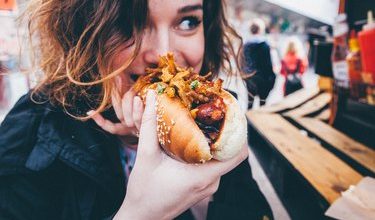The Unexpected Benefits of Low-Carb Diets for Women Over 50

Getty Images/Stigur Mar Karlsson Heimsmyndir
The combination of changing hormone levels and loss of muscle mass can make it more difficult for women over 45 to lose weight. While low-carb eating is a popular weight-loss tool, it also comes with some other health benefits, including knee pain reduction, according to a 2019 study in Pain Medicine.
But before you ditch all your bread and pasta, talk to your doctor to discuss the benefits and risks of a low-carb diet for you.
Video of the Day
Video of the Day
Benefits of a Low-Carb Diet for Women
Both low-carb and low-fat diets can be effective for weight loss, according to the American Association of Retired Persons (AARP). But the low-carb diet has some additional health benefits worth considering. The above-mentioned study tested the effects of a low-carb and low-fat diet on knee pain in adults with osteoarthritis, which affects 15 percent of the U.S.
After assigning subjects to either a low-carb or low-fat diet, researchers found that the low-carb diet was more effective in reducing knee pain. The authors even go so far as to suggest the low-carb diet may present an alternative to pain-relieving opioids.
Additionally, low-carb diets may help improve HDL (good) cholesterol and triglyceride levels more effectively than more carb-heavy diets, according to the Mayo Clinic. That’s likely due in part to the nature of the low-carb diet — lots of lean proteins, healthy fats and unprocessed carbs — so the food choices are typically healthier than the standard American diet.
Today, low-carb diets have taken several popular forms, including the keto diet, the paleo diet and the Mediterranean diet. While each of these options comes with its own nuances, they’re all based around lowering carbohydrate intake, while increasing the amount of healthy fats you eat.
Low-Carb Diet Basics
There’s no one-size-fits-all low-carb diet guide, but most plans start you off on a very low-carb regimen, gradually and slowly adding carbs once weight is lost. Typically, low-carb diets begin by restricting carbohydrates down to 20 to 60 grams per day, according to the Mayo Clinic. Most of the carbs eaten in a low-carb diet are derived from vegetables like leafy greens or cauliflower.
After people lose weight, most low-carb diets slowly reintroduce carbohydrates into the meal plan. Carb cycling is a popular way many people re-integrate carbs into their diet, according to the Cleveland Clinic. This means organizing the amount of carbs you eat for the week based on your more or less active days. On days you’re more active, you eat meals with a little higher carb count, whereas on more sedentary days, you go back to low-carb.
What to Eat on a Low-Carb Diet
To keep carbs low, you’ll be eating mostly carb-free proteins such as beef, pork, chicken, turkey, eggs and seafood. Cheese is also rich in protein, but most types have about one gram of carbohydrates per ounce.
But fiber is important for women in their 40s, as it keeps blood sugar levels from spiking too rapidly, according to the University of California San Franchisco Medical Center. A low-carb diet makes it difficult for you to get the recommended 25 grams a day, which is why it’s necessary to include plenty of non-starchy veggies on your plan.
This includes alfalfa sprouts, asparagus, spinach, bok choy, kale, broccoli, cauliflower, mushrooms, cucumbers, lettuce and onions. These veggies each have five grams of net carbs or less per serving, according to Yale Medicine. Since they don’t spike your blood sugar, they’re not included in the “net carb” count, which refers to the carb content in foods after you subtract the fiber.
Fruits are also high in fiber, but many are also too high in carbs to fit a low-carb plan. But pumpkin, olives and avocados each have less than five grams of net carbs per serving.
Soy foods, including tempeh, tofu and edamame, are also low in net carbs, with three to six grams per serving, and as a source of protein, serve as a meat alternative. While some soy foods are packed with fiber, vitamins and minerals, stay away from soy isoflavone supplements and foods containing soy protein isolate, according to Harvard Health Publishing.
Finally, round out your meals with carb-free fats such as olive oil, ghee or avocado oil. Watch out for salad dressings, as a lot of them have hidden sugars. Or consider making your own low-carb dressing.
Sample Low-Carb Meal Plan
If you’re set on 30 grams of carbs a day, for breakfast you might have a crustless frittata made with eggs, Swiss cheese and chopped asparagus and onions; serve it with bacon or cooked ham. Or try two low-carb pancakes made with low-carb, almond flour-based baking mix.
For lunch, you might opt for lean chicken breast stir-fried with broccoli, bok choy, mung bean sprouts, sesame oil and soy sauce. You might also consider mixed greens topped chopped steak, sliced boiled eggs, cucumbers, crumbled bacon and an olive oil-based dressing.
Finish the day with broiled salmon with roasted Brussels sprouts and turnips. A bunless burger topped with cheddar cheese, lettuce and tomato also makes a good dinner. Serve with fresh green beans sauteed in olive oil and garlic.
Low-carb snack options include avocado, hard-boiled eggs, celery sticks, olives or sliced cucumbers. While deli meats are “allowed” on a low-carb diet, they often have harmful ingredients, like nitrates, according to the University of Virginia UVA Cancer Center. Choose your deli meats wisely.
If you have a few carbs to spare, throw in a handful of fiber-rich nuts every once in a while. An ounce of pecans, hazelnuts or almonds has one to three grams of net carbs each. But, if you’re in it for weight loss, be mindful of the calorie count. Nuts are nutritious but calorie dense snacks, so be sure you’re eating a lean portion.




